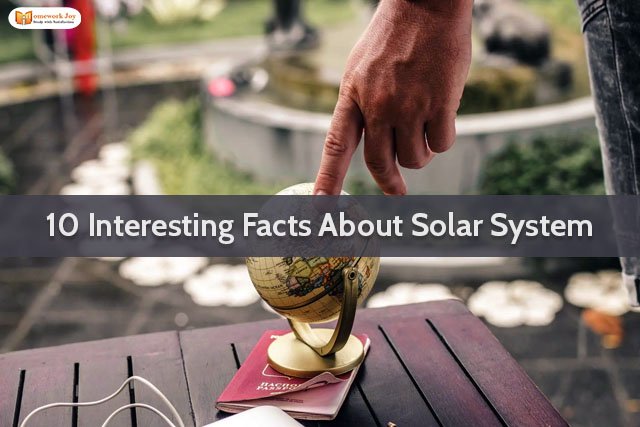The interesting facts about the solar system contain that it is a group of objects that interact with one another. All objects in the solar system orbit around the Sun. Moreover, they move in elliptical paths. The fundamental force that keeps objects revolve around Sun in a particular orbit is gravity.
“When you look at the stars and the galaxy, you feel that you are not just from any particular piece of land, but the solar system.” –Kalpana Chawla, Astronaut
To know what solar system means, we need to break it into two words. Firstly, the word “solar” means “of the sun,” and secondly, the term “system” means “collection of words.” According to scientists, the solar system formed approximately 4.6 billion years ago by the collapse of a giant molecular cloud. The fact about the solar system is that this collapse of the giant molecule formed the planets and other bodies of the solar system.
Main Objects in the Solar System
The Solar System has the Sun and other objects that orbit around it, including planets, moons, stars asteroids, comets and meteors, gas, and dust. According to the current knowledge, our solar system has:
- 1 Star (The Sun)
- 181 Moons
- 3,100 Comets
- 8 Planets ( Mercury, Venus, Earth, Mars, Jupiter, Saturn, Uranus, and Neptune)
- 5 Dwarf Planets (Pluto, Ceres, Haumea, Makemake, and Eris)
- 566,000 Asteroids
In terms of mass, the fact about the solar system is that the Sun composed 99.8% of the Solar System’s total weight. Nearly three-quarters of its weight is hydrogen, and the rest of that is helium with a mark of oxygen, carbon, neon, and iron. Yet it is 330,000 times that of Earth. After that, planet Jupiter is accounting for most mass.
10 Need-to-Know Facts About Solar System
The following are some interesting facts about the solar system that you must know.
1. Pluto Has Mountains
At first, scientists thought that Pluto is a dwarf planet that has a stable environment. But some recent discoveries show that it has icy mountains, which are 11,000 feet or 3,300 meters high. The presence of these mountains indicates that Pluto must have been geologically active as little as 100 million years ago. However, the geological activity requires energy, and this source of energy inside Pluto is a mystery.
2. Smaller Bodies Can Also Have Moon
As a fact about the solar system, most people used to think that only large objects like planets have moons or natural satellites. Since it is unreasonable that small celestial bodies had enough gravity to hold a moon. But in 1993, the Galileo investigated 20-mile wide asteroid Ida and discovered that it has a one-mile-wide moon, named Dactyl. Since then, moons discovered orbiting many minor planets in our solar system.
3. Hottest Planet Isn’t Close to the Sun
In general, people assume that planets that are closer to the Sun are hotter. The average temperature of Mercury, which is closest to the Sun, is about 427 degrees Celsius. However, Venus is hotter than Mercury. Its average temperature is about 468 degrees Celsius as Venus has a thick carbon dioxide atmosphere, which creates a greenhouse effect. While Mercury has a fragile atmosphere, therefore it cannot trap the Sun’s heat easily. So, the third fact about the solar system is that Venus is hotter than Mercury.
4. Mercury is Shrinking
So far, scientists believed that Earth was the only tectonically active planet in our solar system. But MESSENGER (Mercury Surface, Space Environment, Geochemistry, and Ranging) spacecraft, in 2016, reported that Mercury has cliff-like landforms known as fault scarps. And since they are relatively small, therefore scientists believe that the planet Mercury is still contracting.
5. There Could Be Life Somewhere
Till now, scientists have not found any evidence that life exists somewhere else in the solar system. But scientists have found microbial life on Mars. Since extreme microbes live underwater volcanic vents or in the frozen environment, there is a possibility that they could live on other planets like in the oceans of Jupiter’s Europa or among other locations.
6. Tilted Uranus
Uranus rotates on its side. Scientists explained that it underwent some sort of titanic collisions in the past. This fact of Uranus makes it unique among other planets in the solar system. As Uranus passed in front of a star in 1977, it is clear that Uranus has thin rings.
7. Powerful Winds of Venus
Venus is a planet with a high temperature and high-pressure environment on its surface. Yet above its surface, Venus has a mysterious atmosphere. The Europe Venus Express tracked that its upper winds flow 50 times faster than its rotation. And these winds appear to be getting stronger over time.
8. Number of Solar Systems in Galaxy
Back then, astronomers believed that there is only one solar system with several stars and planets. From the last 17 years, over 4,000 planets found orbiting stars. Now scientists estimate that there may be a hundred billion solar systems in Milky Way galaxy, alone.
9. Earth Has Rare Elements
Earth has mostly iron, oxygen, magnesium, sodium, sulfur, nickel, silicon, calcium, and aluminum as elemental composition. These elements can be detected in the vast solar system but in very little quantity, which is mostly overshadowed by the abundance of helium and hydrogen. Therefore most parts of the planet Earth composed of rare elements.
10. Saturn Can Float on Water
Saturn is a gas giant, and it holds about ninety-two percent of the planetary mass in the Solar System. Mostly helium and hydrogen together compose Saturn. Being a massive planet, the density of Saturn is so low that it can float on water. Since its core is considerably denser than water. Its average density is 0.69 grams per cubic centimeter.
These were some interesting facts about the solar system that you might not know. Read them thoroughly and learn something new.
